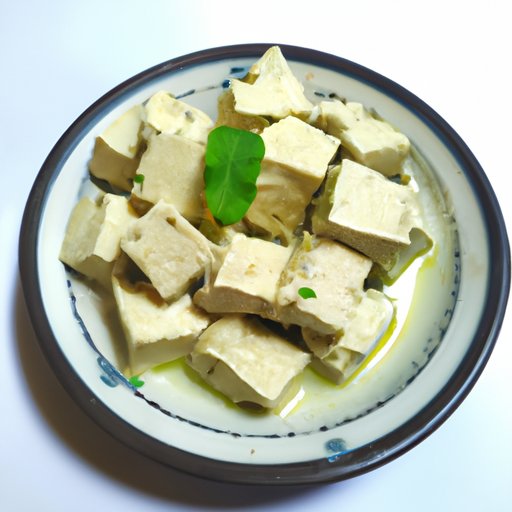
I. Introduction
Paneer, a type of Indian cheese, is a versatile ingredient that can be used in many recipes. Making your own paneer at home is easy and offers many benefits over store-bought versions. In this article, we will provide a step-by-step guide to making paneer, as well as recipes, tips, and the health benefits of using paneer in your cooking.
II. A Step-by-Step Guide to Making Paneer
Making paneer at home requires only a few ingredients and equipment:
- 1 gallon whole milk
- 1/4 cup lemon juice or white vinegar
- Cheesecloth
- Colander
1. Heat the milk in a large pot over medium heat until it comes to a boil.
2. Remove the pot from heat and add the lemon juice or vinegar. Stir gently until the milk curdles and separates from the whey.
3. Line a colander with cheesecloth and place it over a bowl. Pour the milk mixture over the cheesecloth and let it drain for about 30 minutes.
4. Gather the ends of the cheesecloth and twist it gently to squeeze out any remaining whey. Place a heavy object, such as a pot or a book, on top of the cheesecloth to press the paneer for another 30 minutes.
5. Remove the cheesecloth and transfer the paneer to a container. It can be used immediately or stored in the refrigerator for up to three days.
Tips:
- Use fresh and high-quality milk for the best result.
- Do not over-stir the milk mixture or the paneer will become tough.
- Pressing the paneer longer will make it firmer and more crumbly.
III. Paneer Recipes
Paneer can be used in many dishes, from appetizers to main courses. Here are some delicious recipes to try:
1. Paneer Tikka
Paneer tikka is an Indian appetizer made by marinating paneer cubes and vegetables in spices and grilling or baking them. It is a great option for parties or a quick snack.
2. Mattar Paneer
Mattar paneer is a popular North Indian dish made with paneer and green peas in a tomato-based sauce. It is usually served with rice or flatbreads.
3. Palak Paneer
Palak paneer is a vegetarian dish made with paneer cubes and spinach in a creamy sauce. It is a nutritious and delicious option for dinner.
Tips:
- Paneer can also be used in salads, sandwiches, and wraps.
- Marinating paneer in yogurt or spices before cooking can enhance its flavor.
- Paneer can be grilled, sautéed, or fried for different textures.
IV. A Beginner’s Guide to Making Paneer
If you are new to making paneer, here is a basic method:
1. Heat the milk in a large pot over medium heat until it comes to a boil.
2. Reduce the heat to low and add 2 tablespoons of lemon juice or vinegar, stirring gently until the milk curdles.
3. Pour the milk mixture over cheesecloth in a colander, and let it drain for about 10 minutes.
4. Gather the ends of the cheesecloth and twist it gently to squeeze out any remaining liquid. Place a heavy object on top of the cheesecloth to press the paneer for another 10 minutes.
If you prefer not to use lemon juice or vinegar, you can use yogurt or citric acid as an alternative. Adjust the amount according to the instructions on the package.
Troubleshooting:
- If the milk does not curdle, add more lemon juice or vinegar, one tablespoon at a time.
- If the paneer is too dry or crumbly, try pressing it for a shorter time or adding more milk.
- If the paneer is too soft or moist, press it for a longer time or use a higher fat content milk.
V. Comparing Store-bought vs Homemade Paneer
Homemade paneer has many advantages over store-bought versions:
- It is fresher and has a better flavor.
- You can adjust the texture and consistency to your preference.
- It is more affordable than buying pre-made paneer.
- You can avoid preservatives and additives.
While store-bought paneer is convenient, making your own paneer is easy and rewarding.
VI. Variations of Paneer
You can vary the texture and flavor of paneer by adding different ingredients or seasonings:
- For a softer paneer, add more milk or cream.
- For a spicier paneer, add red chili powder or garam masala.
- For a sweeter paneer, add honey or sugar.
- For a tangy paneer, add tomato or tamarind paste.
Experiment with different ingredients and find your favorite flavor combinations.
VII. Health Benefits of Paneer
Paneer is a great source of protein and calcium, which are important for maintaining strong bones and muscles. It also contains vitamin B12, phosphorus, and selenium.
Paneer is a good option for vegetarians and those on a low-carb diet. It is also gluten-free and can be used in vegan recipes by replacing it with tofu or another alternative.
VIII. Conclusion
Making paneer at home is a simple and rewarding process that offers many benefits over store-bought versions. With this guide, you can learn how to make perfect paneer every time, and discover tasty recipes and variations to incorporate paneer into your cooking.





